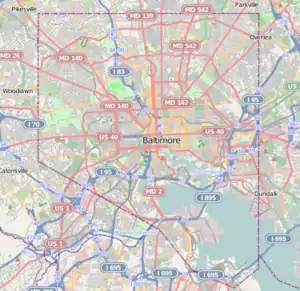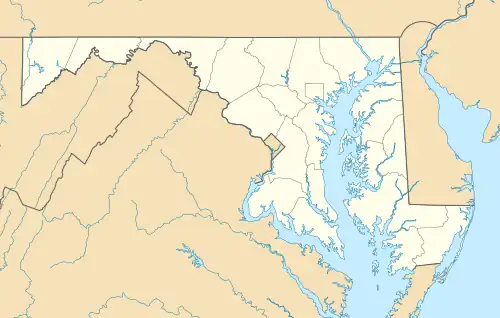Peale's Baltimore Museum | |
.jpg.webp) Peale Museum | |
   | |
| Location | 225 North Holliday Street, Baltimore, Maryland |
|---|---|
| Coordinates | 39°17′30.89″N 76°36′38.28″W / 39.2919139°N 76.6106333°W |
| Built | 1814 |
| Architect | Robert Carey Long, Sr. |
| Architectural style | Georgian |
| NRHP reference No. | 66000915 |
| Significant dates | |
| Added to NRHP | October 15, 1966[1] |
| Designated NHL | December 21, 1965[2] |
| Designated BCL | 1971 |
The Peale, located in Baltimore, Maryland, is Baltimore's Community Museum. Its mission is to evolve the role of museums in society by providing local creators and storytellers with the space and support the need to realize a complete and accessible cultural legacy for the city of Baltimore.[3] In August 2022, The Peale held a grand re-opening ceremony after the completion of a five-year restoration process.[4]
The Peale occupies the first building in the Western Hemisphere to be designed and built specifically as a museum.[5] The museum was imagined by American artist and inventor Rembrandt Peale (1778–1860) and designed by architect Robert Cary Long, Sr.[6]
Peale's original museum closed in 1829. The building later served as Baltimore's City Hall from 1830 to 1875 after which it became the Male and Female Colored School No. 1 from 1878 to 1887.[7] The school was one of the first grammar schools and the first high school for African American students in Baltimore.[7]
History
In 1814, artist Rembrandt Peale established The Peale Museum at 225 North Holliday Street between East Saratoga and East Lexington streets in Baltimore. Rembrandt was the second son of artist and museum founder Charles Willson Peale. Rembrandt Peale's museum was dubbed as "Peale's Baltimore Museum and Gallery of Fine Arts" and featured portraits of famous Americans, including some by its founder, as well as the complete skeleton of a prehistoric mastodon exhumed by Charles Willson Peale in 1801.[8] During the Battle of Baltimore a month after opening, Rembrandt Peale, his wife, and seven children spent the night in the museum hoping that the British military would think the museum was their home and spare the building.[9]
The fame of Peale's museum was such that it was occasionally described as simply the "Baltimore Museum."[10] Rembrandt's brother, Rubens Peale, managed the museum until 1829.[11]
Extensive reviews by John Neal of the museum's annual exhibitions in 1822 and 1823 are some of the earliest published works of American art criticism.[12]
The Peale Museum was the first building in Baltimore to have gas lighting.[13]
In 1829, the museum was sold due to financial difficulties and the exhibits were moved to a newly constructed building on the northwest corner of North Calvert Street and East Baltimore Street, one block south of the Battle Monument Square and the Baltimore City Courthouse. From 1830 to 1875, the museum's former building served as Baltimore's first City Hall.[14]
The building was turned over to the city's Board of School Commissioners and the Baltimore City Public Schools. In 1878, it became the Male and Female Colored School No. 1.[14] The school, which operated until 1887, was one of the first grammar schools and the first high school for African American students in Baltimore.[7]
The Peale building housed the Bureau of Water Supply from 1887 to 1916[8] and was rented by various shops and factories from 1916 to 1928.
By 1928, the building had been repeatedly condemned and was in danger of demolition. The building was renovated and rededicated in 1931 as the Municipal Museum of Baltimore.[14] The renovation of the building was supervised by John Henry Scarff, a Baltimore-born architect, painter, and archaeologist, who later worked closely on policies governing looted art and damaged monuments during and after World War II.[15]
The building was designated a National Historic Landmark in 1965.[8]
The building underwent a major two-year renovation starting in 1978 and was reopened in 1981 as the Peale Museum. In 1985, The Peale became part of the Baltimore City Life Museums (BCLM), a consortium of historic homes, building and sites.[8][16]
BCLM folded in 1997 and the entire Peale collection was moved to the Maryland Historical Society, now called the Maryland Center for History and Culture, leaving the original building on North Holliday Street vacant until it was reopened for periodic public programs and events in 2017.
In 2014, a campaign was being waged by a Maryland group to raise $4 million for restoration of the museum.[17] The restoration project was completed in 2022 and a grand reopening ceremony took place in August 2022.[4]
See also
References
- ↑ "National Register Information System". National Register of Historic Places. National Park Service. January 23, 2007.
- ↑ "Peale's Baltimore Museum". National Historic Landmark summary listing. National Park Service. Archived from the original on October 10, 2012. Retrieved March 30, 2009.
- ↑ "The Peale – Baltimore's Community Museum". Retrieved May 27, 2022.
- 1 2 "Filled with firsts, the Peale reopens its historic doors as a community museum". Baltimore Sun. Retrieved August 15, 2022.
- ↑ Mendinghall, Joseph S. (February 28, 1975). "National Register of Historic Places Inventory Nomination: Peale's Baltimore Museum". National Park Service. Retrieved March 30, 2009.
- ↑ "Long Sr., Robert Cary — Baltimore Architecture Foundation". Retrieved June 4, 2021.
- 1 2 3 "Male & Female Colored School No. 1 at the Peale – The Peale". Retrieved May 27, 2022.
- 1 2 3 4 "National Register Properties in Maryland". mht.maryland.gov. Retrieved August 16, 2022.
- ↑ "History of the Peale". The Peale Center for Baltimore History and Architecture. Retrieved April 25, 2021.
It opened in August 1814. The following month, the British attacked Baltimore in the culmination of their Chesapeake campaign during the War of 1812. Afraid they would burn the city and with it his new museum, as they had the Capitol and the White House in Washington, D. C., Rembrandt, his pregnant wife and their seven children spent the night in the building during the Fort McHenry bombardment, hoping that the British would think it was their residence and spare it.
- ↑ Orkaby, Asher; Goodall, Jamie; Muir, Meaghan L.; Desai, Sukumar P. (2020). "Padihershef: The MGH Mummy Who Oversaw Two Centuries of Medicine and Egyptology". Massachusetts Historical Review. 21: 143. JSTOR 27023727.
For six weeks in June and July 1824, Padihershef resided in Baltimore, primarily at the Baltimore Museum on Holliday Street, where he raked in an astonishing $1,842.
- ↑ "Peale Museum · Built to Last: Enduring Landmark's of Baltimore Central Business District · Baltimore Heritage Digital Collections". collection.baltimoreheritage.org. Retrieved August 16, 2022.
- ↑ Chico, Beverly Berghaus (Fall 1976). "Two American Firsts: Sarah Peale, Portrait Painter, and John Neal, Critic" (PDF). Maryland Historical Magazine. 71 (3): 349–358.
- ↑ "Built to Last: Peale Museum" (PDF). National Park Service - Built to Last. 1.
- 1 2 3 "Built To Last: Ten Enduring Landmarks of Baltimore's Central Business District: Heritage Documentation Programs--HABS, HAER, HALS, CRGIS--of the National Park Service". www.nps.gov. Retrieved August 16, 2022.
- ↑ "Scarff, John H. | Monuments Men and Women | Monuments Men Foundation". MonumentsMenWomenFnd. Retrieved August 15, 2022.
- ↑ "History of the Peale – The Peale". Retrieved May 27, 2022.
- ↑ Wenger, Yvonne (April 4, 2014). "New life envisioned for old Peale Museum downtown". The Baltimore Sun. Retrieved January 9, 2015.
External links
- Peale's American Museum information from the Academy of Natural Sciences
- Historic American Buildings Survey (HABS) No. MD-398, "Rembrandt Peale Museum, 225 North Holliday Street, Baltimore, Independent City, MD]"
- Peale Museum – Explore Baltimore Heritage
- Peale's Baltimore Museum, Baltimore City, including undated photo, at Maryland Historical Trust


